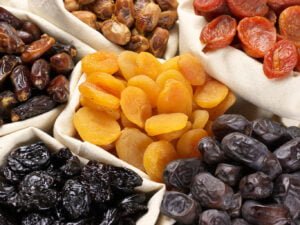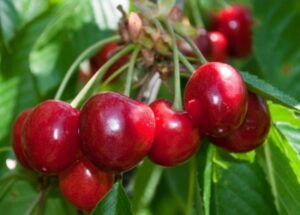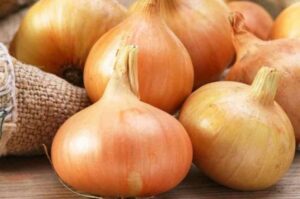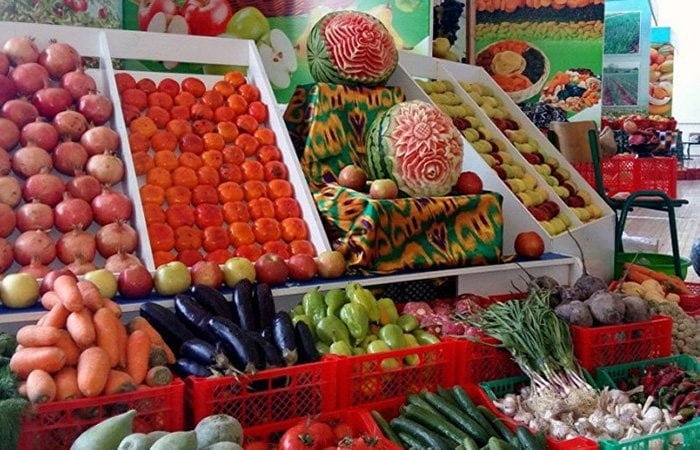The EastFruit team sums up the results of the 2020 fruit and vegetable year for Uzbekistan. This year turned out to be very difficult for the participants in the horticulture business due to late spring frosts during the flowering of orchards and vineyards, the collapse of the Sardobin dam, uncertainty and restrictions on the market, and logistics for fresh fruit and vegetable products as well as the drop in incomes of the population caused by the COVID-19 pandemic all of which was reflected in the fruit and vegetable market.
Given these difficulties, it is not surprising that the volume of exports of fruits and vegetables for 11 months of 2020 decreased by 17.8% in value terms.
To begin with, we will consider the dynamics of Uzbek fruit and vegetable exports in the main directions, after which we will analyze the main events of the horticulture market for the year in chronological order and give a list of the most popular and profound publications by EastFruit for 2020.
In terms of the positive developments, it is worth noting the increase in direct supplies of fruits and vegetables from Uzbekistan to Russia due to the reduction in the Russian Federation of the VAT rate for this category of products. Considering also the rise in prices, Uzbekistan’s revenue from direct exports to Russia in the first 11 months of 2020 increased by 64% and reached $274 million. The main export positions were fresh table grapes (increased 2.2 times to $63 million), peaches and nectarines (increased 3.4 times to $36 million), fresh apricots (increased 56% to $22 million), fresh greenhouse tomatoes (increased 27% to $22 million), persimmons (increased 2 times to $19 million) and fresh cherries (increased 3.3 times to $17 million). Also, many fresh herbs, onions, cabbage, plums, broccoli, cauliflower, melons, and watermelons were exported to Russia from Uzbekistan.
Considering the increase in the supply of Uzbek fruit and vegetable products directly to Russia, their supplies to Kazakhstan, formerly one of the main transit countries, decreased by 20% in the first 11 months of 2020 by 34% to $198 million. The main export positions were fresh table grapes (decreased by 34% to $45 million), fresh greenhouse tomatoes (increased 54% to $22 million), persimmons (increased 13% to $16 million), and peaches (34% drop to $15 million). A lot was also exported from Uzbekistan to Kazakhstan such as onions, cherries, fresh apricots, cabbage, melons, watermelons, and fresh herbs.
Yet, exports of Uzbek fruits and vegetables to China in 2020 fell sharply more than twice in the first 11 months of the year and reached only $12 million. Supplies of Uzbek raisins (dried grapes) to China fell by 45% to $11 million and supplies of dried apricots and cherries were comparatively insignificant and decreased by 38% and 89% respectively.

Even Ukraine imported more fruits and vegetables from Uzbekistan in 2020 than China. There are data on Ukraine for only 10 months, but even so, the export of Uzbek products to Ukraine for this period already exceeds supplies to China totalling $14 million. However, there is also a decrease in exports of 24%. If the supply of melons, fresh apricots, and fresh herbs increased 2 times, 2.4 times, and 19%, respectively becoming the main export positions, then the exports of Uzbek raisins to Ukraine fell more than twice and onions more than six times.
Uzbek exports of fruits and vegetables to Turkey also decreased by 28% in 11 months of 2020 to $30 million. The largest drop was noted in the main export position of Uzbekistan to Turkey, which was raisins. Here, exports decreased by 28% to $9.6 million. However, the exports of almonds increased by 73% to $9.4 million and preserves by 32% to $4.2 million. The proceeds from the exports of Uzbek walnuts to Turkey decreased both in-shell and without, but this was primarily due to the fall in world prices for nuts. The export supplies of Uzbek dried apricots to Turkey increased more than 12 times.
Let’s now return to the events of the fruit and vegetable market in Uzbekistan according to their chronology.
In January 2020, we figured out which fruits can be called “premium” in the winter period in Uzbekistan and they identified cherries, which were sold, one might say, by the piece for $45-50 and fresh apricots from the Southern Hemisphere at $31 per kg. A year has passed, and now cherries in supermarkets in Tashkent have dropped somewhat in price and they can be purchased in January for $40-45 per kg.

In February 2020, Kyrgyz apples plummeted in price in the Uzbek market. They could be bought on the wholesale markets of Uzbekistan even at $0.60 per kg. The price came as a shock to local entrepreneurs and producers who announced plans to sell their apple reserves for no less than $2 per kg in the first months of 2020.
Also in the same month, East-Fruit’s Telegram channel became the most active agricultural news source in Uzbekistan! The largest agricultural channel Agro-Olam.uz had, at that time, more than 27,000 subscribers. However, over the year Agro-Olam.uz has slightly lost its popularity and now the number of its subscribers dropped to 26,300. In contrast, the East-Fruit Telegram channel continues to gain popularity and now the number of its subscribers is 2,600 (versus 1,900 subscribers back in February 2020).
February 2020 continued to be eventful when the first investment in 10 years by the European Bank for Reconstruction and Development (EBRD) in the Uzbek supermarket chain Korzinka.uz was officially approved. What is remarkable is that this investment allowed the retail trade of Uzbekistan to move to a new stage of development. In general, EastFruit in 2020 paid a lot of attention to the boom in the development of supermarket chains in Uzbekistan, because it is this factor in the coming years that will most significantly affect the changes in the production and wholesale of fruits and vegetables.

In March 2020, a sharp drop in wholesale and retail prices for onions was recorded in Uzbekistan by an estimated 35-40%. The reason for this was the suspension of exports due to the COVID-19 pandemic’s spread to Uzbekistan and complications with border crossings.
Also in March, a historic event took place for the fruit and vegetable industry in Uzbekistan in which decrees were signed on the liberalization of cotton and grain growing. It is this decision that can lead to a sharp increase in the volume of investments in farming, viticulture, and growing nuts, berries, and vegetables. We will be able to see the first results of liberalization soon when summing up the official results of the development of agriculture in Uzbekistan in 2020.
April 2020 did not start off well in Uzbekistan. During the nights of April 8-9, 2020, a sharp drop in air temperature was observed in Uzbekistan causing frosts down to minus 2-4 degrees and heavy snowfalls with a sufficiently strong wind. Crop losses from frost were estimated at 15-20%.
In mid-April, the situation became even more complicated because farmers had a problem with the pollination of fruit trees. This problem was caused by strict quarantine, which did not allow beekeepers, especially near large cities, to care for bees.
However, already at the end of the month, news began to arrive that the first early fruits appeared on the market which was cherries, early apples, and apricots.
In early May 2020, the first consignments of Uzbek cherries were already sold in-full on foreign markets. Just some 10 years ago, this would have been considered unthinkable since no one would have expected these fruits to appear on the market before late May or early June.
The coronavirus pandemic forced the government to look for ways to ensure the country’s food security. The initiative to fine owners of household plots in Uzbekistan for not using them for growing potatoes and vegetables was widely discussed.
In May 2020, Uzbekistan expanded subsidies for the exports of fruits and vegetables by road and air transport. Prior to this, only export shipments by rail were subsidized. According to EastFruit analysts, this was a very timely decision as exporters faced increased transportation costs and other difficulties caused by the coronavirus pandemic.
By June 2020, the activation of exports began to cause discontent on the part of the population of Uzbekistan. We believe this is not entirely justified since the development of exports of fruit and vegetable products allows rural residents to improve their living standards and expand production, creating a large number of well-paid jobs. Also, the expansion of exports of fruit and vegetable products creates new jobs in cities as export requires packaging, logistics, financing, insurance, and a host of other related products and services. Accordingly, the increase in income exceeds the increase in product prices. In the long run, exports also lead to a decrease in domestic prices because high prices stimulate new investments in production, which means that the supply of products is growing. If there is interference with exports then production will be curtailed due to disadvantages, which means that prices will be much higher in the long run.
EastFruit’s June audit of the fruit and vegetable departments of supermarkets in Tashkent showed that retail prices for most types of fruits and berries in the capital of Uzbekistan increased significantly over the year. Consumers paid on average 37% more for the same set of fruits as at the end of June 2019.
In July 2020, exports of fresh fruits and vegetables from Uzbekistan reached its peak. However, the export results for the first half of the year were not encouraging. Exports of fruits and vegetables fell by 40%, but official sources spoke of an increase in production volumes.
Also in July, EastFruit summed up the results of the retail audit of the fruit and vegetable departments of Uzbekistan where Korzinka.uz was the leader. However, this was before several large players entered the country’s market at once in the second half of the year, after which the market situation changed dramatically.
In this regard, there have been many reports of investments in infrastructure for the storage and processing of fruits and vegetables. Therefore, the blog “Top-10 mistakes in planning the infrastructure of the fruit and vegetable market (wholesale markets, storage facilities, distribution centres, etc.),” published in early August on EastFruit was actively discussed in Uzbekistan.
In August 2020, much attention was paid to the infrastructure of the horticulture business in Uzbekistan. Plans included the construction of a huge trade and distribution centre on its border with Kazakhstan, creating a transit corridor for the delivery of Uzbek products to Afghanistan and Iran, the Netherlands announced the possibility of helping Uzbekistan to create a new system of knowledge and innovation in agriculture, and China sought about helping Uzbekistan to improve its work in phytosanitary laboratories.
However, there were also negative events. The first was a ban on plum imports from Uzbekistan to Kazakhstan due to the detection of quarantine organisms in its products. By the end of 2020, there were many more such events. Meanwhile, the pace of fruit and vegetable exports still lagged behind 2019.
At the beginning of autumn, we analyzed how Uzbekistan can strengthen its position among the world leaders in fruit exports and came to the conclusion that it required improving the quality and safety of products, more modern set of varieties, and improved approaches to storage, cooling, processing, and packaging would allow Uzbekistan to solve one of its main problems which is the high level of dependence on product supplies to Russia.

The nut business of Uzbekistan in 2020 suffered from low world prices. However, this business remains very promising for the country.
It should also be noted that among the most popular materials in 2020 from EastFruit’s Youtube channel, there were several videos about walnuts, almonds, and pistachios. They were very often watched in Uzbekistan, which indicates a high interest in the walnut business in this country. Here are links to those popular videos:
- Harvesting Chandler walnuts in Georgia’s largest modern orchard with drying and processing at Agrovia
- Seven-year-old Chandler walnut orchard in California
- How to get 3 tons of walnuts per hectare in the third year
- Technology, techniques, and the economics of growing and marketing almonds in California
- Technology of growing pistachios in California
Also, EastFruit’s annual review “Nut business: 2020 market summary for walnuts, almonds, hazelnuts, pistachios and other nuts” has been read by 15,000 people!
In November 2020, we wrote our article identifying the top 10 problems for intensive apple orchards in Uzbekistan, Kazakhstan, and other Central Asian countries. This resonated throughout the region and in Uzbekistan as well. We explained why it is not worth growing vegetables and potatoes in the aisles of intensive orchards, because EastFruit received regular complaints from Uzbek farmers that officials were forcing them to do this.
The onset of cold weather revealed additional problems in the horticulture sector of Uzbekistan, in particular, problems with its greenhouse business. Our article “Why is Uzbekistan killing their successful greenhouse industry?” pointed out the obvious problems of greenhouses in Uzbekistan, who, unlike producers of greenhouse vegetables from neighbouring countries, did not have guaranteed access to natural gas. At the same time, Uzbekistan was a large exporter of gas and preferred to sell it in the form of raw materials than in the form of products with high added value, which are greenhouse vegetables and berries.
This was just the beginning of the problems of the greenhouse sector in Uzbekistan. In November, reports from Rosselkhoznadzor began to arrive about a ban on the imports of greenhouse tomatoes and peppers from regions in Uzbekistan. A quick survey of subscribers on EastFruit’s Telegram channel showed that 74% of readers share the point of view on the political background of detecting quarantine objects and only 26% believe that the main reason is the poor plant protection system of farmers in Uzbekistan.
However, this was only the beginning. Russia discovered a new quarantine organism on Uzbek dried apricots and introduced new bans on supplies. It then extended the ban on the supply of greenhouse tomatoes and peppers to suppliers from the Kashkadarya and Navoi regions of Uzbekistan due to the detection of the tomato brown rugose fruit virus (ToBRFV) as was the case of supplies from the Fergana Valley as well. In general, at the end of the year, Russia began to actively limit the imports of fruits and greenhouse vegetables from many countries. All these market troubles have led to an increase in wholesale prices for greenhouse vegetables in Uzbekistan by an average of 79% per year.
Yet, November was not just marked by problems. The retail audit of the fruit and vegetable departments of supermarkets in Uzbekistan revealed a new leader, the Green Apple chain, which pushed aside the traditional leaders Korzinka.uz and Makro in the rating of fruit and vegetable departments.
The topic of supermarkets in Uzbekistan also flowed into December. At the beginning of December 2020, another ambitious newcomer entered the market – Baraka Market – who decided to open five stores at once! Also, by the end of December in the capital city of Tashkent, the first store of the international supermarket chain Carrefour finally opened.
Already in January 2021, we quickly analyzed how successful the retail newcomers were in the fruit and vegetable trade. It turned out that both Carrefour and Baraka Market could not squeeze the leaders of the fruit and vegetable trade, but Carrefour was noted for very low prices.
Therefore, in 2021, we should expect a continuation of the supermarket boom. For example, the largest retailer of Kazakhstan, Magnum Cash & Carry, announced ambitious plans to enter the Uzbek market. The low vegetable prices at Carrefour shows that supermarket chains are aiming to fight bazaars in price as well as each other. Also, there is an obvious shortage of retail space for new stores, in particular, the first high-profile conflict over retail space between Carrefour and Makro arose recently.
This concludes the 2020 review for the fruit and vegetable sector in Uzbekistan. Time will tell whether the country’s exporters will be able to take advantage of the new opportunities in 2021. Let’s hope for the absence of serious weather disasters and for the normalization of logistics, which has a key impact on Uzbek fruit and vegetable exports.
The use of the site materials is free if there is a direct and open for search engines hyperlink to a specific publication of the East-Fruit.com website.




